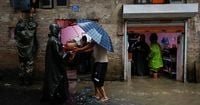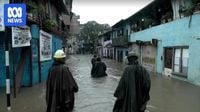Heavy monsoon rains have unleashed a wave of devastation across Nepal and parts of neighboring India, leaving more than 60 people dead, dozens missing, and entire communities cut off from vital supplies and rescue operations. As of Sunday, October 5, 2025, officials in both countries were scrambling to respond to the crisis, which has overwhelmed infrastructure and tested the resolve of new political leadership in Nepal.
The disaster struck with little warning late last week, when torrential downpours began pounding the Himalayan foothills. By Friday, rivers in Nepal and northern India were in full spate, and the first reports of landslides, flash floods, and lightning strikes began to trickle in. According to Nepal's National Disaster Risk Reduction and Management Authority, at least 44 people had died in Nepal alone by Sunday, with five still missing. The worst-hit region was the eastern Ilam district, bordering India, where multiple villages were swept away and at least 37 people lost their lives. Local officials reported the heartbreaking loss of six members of a single family, crushed when their home was buried overnight by a landslide.
"Heavy rains overnight caused the landslides," said Sunita Nepal, a district official in Ilam, as quoted by Agence France-Presse (AFP). Rescue teams, often forced to travel on foot due to blocked roads, have managed to save at least 114 people, but continued rainfall and debris have hampered relief efforts. The Armed Police Force spokesperson Kalidas Dhauboji confirmed that nine people remained missing after being washed away by floods, while three others were killed by lightning strikes elsewhere in the country. The toll is expected to rise as authorities reach more remote areas.
The chaos was not confined to Nepal. Across the border in India's Darjeeling region of West Bengal, at least 20 people died after heavy overnight rain unleashed flash floods and landslides that destroyed homes and infrastructure. Indian lawmaker Harsh Vardhan Shringla lamented, "Areas across the hills have been cut off, and roads destroyed. This has disrupted normal life and caused considerable hardship to many." In Bihar, another Indian state bordering Nepal, authorities reported at least 10 deaths due to floods and lightning, with much of the state placed under emergency alert and citizens advised to avoid low-lying areas.
Transport infrastructure throughout the region has suffered extensive damage. In Nepal, landslides have cut all major routes into the capital, Kathmandu. The Araniko Highway, which links Kathmandu to China’s border, is blocked after multiple road collapses, while the BP Highway connecting the eastern regions is buried under debris. Domestic flights were largely suspended due to poor visibility, leaving hundreds of travelers—many returning after the Dashain festival—stranded. However, international flights at Kathmandu airport continued to operate, albeit with some disruptions. "Domestic flights are largely disrupted but international flights are operating normally," Rinji Sherpa, a spokesperson for Kathmandu airport, told Reuters.
The timing of the disaster could hardly have been worse. The crisis coincided with the end of Dashain, Nepal’s most important religious festival, when hundreds of thousands of people travel across the country to be with family. As the rains intensified, rivers in Kathmandu swelled, inundating settlements along their banks. Security agencies evacuated dozens living in slums along the riverbanks in the Kathmandu Valley, deploying helicopters and motorboats to assist in rescue operations.
With roads blocked and many communities isolated, the government has taken extraordinary measures. Prime Minister Sushila Karki, who leads Nepal’s interim government following recent political upheaval, declared Sunday and Monday as public holidays and urged citizens to avoid travel unless absolutely necessary. "Your safety is our utmost concern. Do not hesitate to seek necessary assistance," she said in a televised address. The Ministry of Home Affairs extended the holiday to Tuesday in some reports, exempting only emergency services and disaster response teams, as the country battles to contain the fallout.
The Nepalese weather department warned that rain was likely to continue until Monday, October 6, with more than a dozen districts placed on red alert. Residents near waterways were advised to evacuate immediately, especially in the provinces of Bagmati, Gandaki, Lumbini, and Madhesh. The Kathmandu Post reported that meteorological authorities have urged vigilance, as the Koshi River in southeastern Nepal surged to more than twice its normal volume. In a rare move, all 56 sluice gates at the Koshi Barrage were opened, compared to the usual 10 to 12, to prevent catastrophic flooding downstream. Local official Dharmendra Kumar Mishra confirmed that authorities were considering restricting heavy vehicles from crossing the bridge due to the river’s dangerous levels.
Amid these immediate dangers, the disaster has highlighted longer-term vulnerabilities. Nepal, a mountainous nation highly prone to natural disasters, suffers hundreds of deaths each year from monsoon-induced landslides and floods. Last year, similar monsoon events killed 224 people and left 158 injured. But experts warn that the frequency and intensity of such disasters are increasing. The International Centre for Integrated Mountain Development, based in Kathmandu, cautioned in June that rising temperatures and more extreme rainfall are elevating the risk of water-induced disasters. "Rising temperatures and more extreme rain raise the risk of water-induced disasters such as floods, landslides, and debris flows," the center stated. Climate change, many scientists argue, is making these events more unpredictable and severe.
The current crisis comes at a time of political instability in Nepal. The interim government, led by Prime Minister Karki, is still struggling to find its footing after violent protests toppled the previous administration. Many government offices were damaged during the unrest, and the new leadership has yet to complete key cabinet appointments. Karki, a retired Supreme Court justice, was brought in by protest leaders who demanded a break from the entrenched political elite. She has called for early elections next year and is working to restore order and trust in the government’s ability to respond to emergencies.
As the Himalayan region braces for continued rain, rescue workers are racing against time to reach cut-off communities in remote mountainous terrain. The Nepalese army has mobilized troops and helicopters for rescue missions in over two dozen locations. Meanwhile, in India, Prime Minister Narendra Modi expressed sorrow over the loss of lives in Darjeeling and said the situation was being closely monitored. Footage from Indian television showed rescue workers using cables to access isolated regions as raging waters smashed into bridges and caved in roads.
For now, the focus remains on saving lives and providing relief to survivors. But as the skies clear and the waters recede, both Nepal and India will face the daunting task of rebuilding—and of preparing for a future where such disasters may become all too common.


